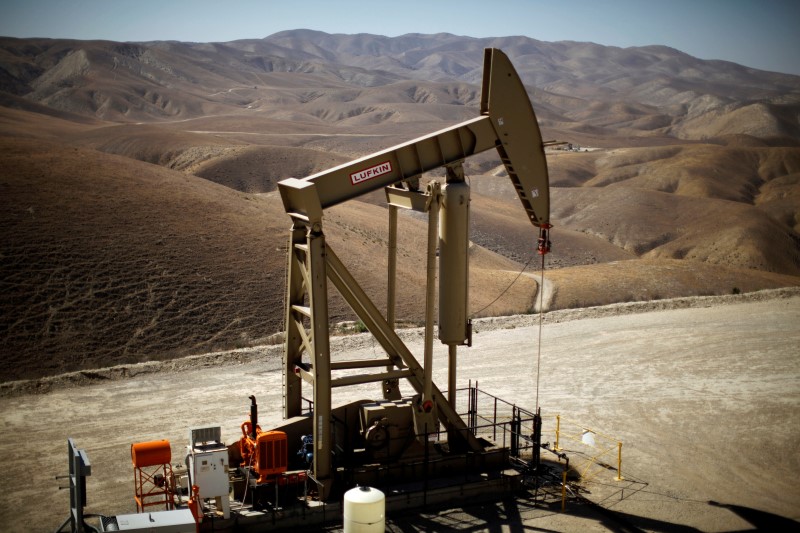By Ernest Scheyder and Terry Wade
HOUSTON (Reuters) - Since the beginning of the U.S. fracking revolution, oil producers have struggled with a vexing problem: after an initial burst, crude output from new shale wells falls much faster than from conventional wells.
However, those well decline rates have been slowing across the United States over the past few years, according to data analysis provided exclusively to Reuters.
The trend, if sustained, would help ameliorate the industry’s most glaring weakness and cement its importance for worldwide production in years to come. It also helps explain shale drillers' resilience throughout the oil market's two-year slump.
While shale oil production revolutionized the oil industry over the past decade, bringing abundance of global oil supplies, high costs and rapid production declines have been its Achilles heel. That is beginning to change thanks to technological innovation and producers' focusing less on maximizing output and more on improving efficiency and productivity.
According to data compiled and analyzed by oilfield analytics firm NavPort for Reuters, output from the average new well in the Permian Basin of West Texas, the top U.S. oilfield, declined 18 percent from peak production through the fourth month of its life in 2015. That is much slower than the 31 percent drop seen for the same time frame in 2012 and the 28 percent decline in 2013, when the oil price crash started.
The change was even more dramatic in North Dakota's Bakken shale, where four-month decline rates for new wells fell to 16 percent in 2015 from almost 31 percent in 2012. (Graphic:http://tmsnrt.rs/292ScGY)
A slower decline means producers need to drill fewer new wells to sustain output, said Mukul Sharma, professor of petroleum engineering at the University of Texas at Austin.
"You can have cash flow without having to expend a lot of capital."
The recent decline rates mark a dramatic improvement from first-year 90 percent declines in the early years of the shale boom that made some investors question the sector's long-run viability.
NEW PHILOSOPHY
There are no 2016 figures yet, but oil executives expect the trend to continue this year and beyond.
Scott Sheffield, chief executive of Pioneer Natural Resources Co (N:PXD), a top Permian producer, credited improved fracking techniques for helping stabilize production, which shareholders rewarded by lifting Pioneer's shares up about 9 percent over the past year.
"We're exposing more of the reservoir and breaking it up so we don't get as sharp a decline," Sheffield told a recent energy conference.
Slower declines also reflect producers' more conservative approach to operating wells. In the early years of the hydraulic fracturing boom, high crude prices encouraged operators to boost initial production as much as possible.
To do this, they would let wells flow fast by keeping pressure low on the ground's surface. About seven years ago, however, some shale operators in Louisiana found this ultimately hurt production later on by causing rock fractures to shut.
Now, many operators maintain surface pressures higher, which limits initial flow rates and slows a well's decline rate.
"Conventional wisdom has shifted," said John Lee, a professor of petroleum engineering at Texas A&M University.
Sharma of the University of Texas said that while shale well decline rates remained far above a 10 percent first-year decline a conventional well might experience, they marked a radical improvement compared with early years of hydraulic fracturing.
Harold Hamm's Continental Resources Inc (N:CLR), for example, has told investors its new wells in Oklahoma's SCOOP region are now producing 40 percent more oil six months into their lives than as recently as last year.
Today's production techniques use larger volumes of sand and pressurized fluids to frack more spots along longer well bores, to extract more oil from the wells. (Graphic: http://tmsnrt.rs/296vBtQ)
Pioneer fracks its wells every 15 feet today compared to every 60 feet in 2013. It costs extra $500,000 per well to do so, but its wells produce two-thirds more oil than just three years ago, boosting profitability, Pioneer said.
To be sure, not all producers are seeing slower decline rates and the newer, more stable shale wells make up only a fraction of all producing U.S. oil wells, so their impact on overall domestic output is for now limited.
The Eagle Ford shale in southern Texas has seen decline rates slightly increase, for example, according to NavPort data.
